
Dock of the Bay

Volume VI Number 32
August 13-19, 1998
Measuring Up to Marsha: In Dist. 33, Looking Green Could Be Key
Gayle Powell, of Crofton, screws a plastic nozzle
into place and slowly pumps compressed natural gas into what looks like
a scuba tank in the trunk of her Ford Contour.
At 76.3 cents a gallon, clean-burning compressed natural gas, CNG, is quite a bargain even if you have to work a little harder driving your car. Since the tank holds just five gallons, more frequent fueling is needed and, as of now, you can find just three fill-up outlets in the Annapolis area.
Good thing Powell's sedan also has a gas tank. Besides transportation, her automobile also lends a ready environmental platform in Powell's contest for the Democratic House of Delegates nomination in District 33.
"It's cleaner for the environment; it pollutes the air less than gasoline vehicles," she said after filling up on CNG recently in Washington.
"It can also have the economic benefit of reducing our country's dependence on foreign oil."
Powell and her Democratic adversaries in the Sept. 15 primary may be wise to stress environmental issues, judging by the record of Marsha Perry, who is retiring from the General Assembly after three terms. Perry's multi-member District 33 seat includes Crofton, Odenton, Gambrills, Crownsville, parts of Severna Park and portions of Southern Anne Arundel County to Lothian.
Besides Powell, three other Democrats are competing for the vacant seat: Sheila Schneider and Marcia Richard, both of Crofton, and Alvin Tilghman, of Severn. Seven Republicans -- two of them incumbents, Robert Baldwin and Janet Greenip--- are vying on the Republican ballot. Three from each party will be on the November ballot.
There are more issues than the environment: education and crime, to name two. But as Powell observed, Perry's environmental activism and her 100 percent ratings from the League of Conservation Voters were a linchpin to her success. The district has more than 400 miles of shoreline and more land along the Chesapeake Bay than any other district.
"She was someone you could always count on to do what is right for the environment. She had a passion for it, and that's important to a lot of people in this area," said Powell.
Here are snapshots of the District 33 Democratic hopefuls:
Powell, 32, a Colorado native, notes that she has been working on environmental issues for nearly a decade. She is especially concerned about clean air issues, which are important not just on land but on the Chesapeake Bay where pollutants fall. Improving mass transit in the region is one alternative she would work for in the Maryland General Assembly. Powell also says that she would fight to require double-liners in Maryland rubble fills to prevent seepage.
 has paid close attention to crime in her community
since the murder of a friend. Indeed, she has become so deeply involved
that she puts on workshops throughout the region on issues related to violence
against women. She lists these issues and victims' rights near the top
of her list of concerns, along with health care for children and economic
issues.
has paid close attention to crime in her community
since the murder of a friend. Indeed, she has become so deeply involved
that she puts on workshops throughout the region on issues related to violence
against women. She lists these issues and victims' rights near the top
of her list of concerns, along with health care for children and economic
issues.
Schneider, 49, is executive director of the Crofton Chamber of Commerce. The goals of businesses sometimes run counter to those of environmental advocates, but Schneider sees no problem in representing both views. "This is a local chamber and you don't see the conflict. People live in the community in which they work. The blending of economic development and what citizens want and need for their community is not diametrically opposed."
 Marcia Richard's work as a teacher equips her to deal
with the many front-of-the-mind education issues prevalent among voters.
As a delegate, she says she would work for a bigger piece of the state
education pie and smaller classrooms. Promoting services for senior citizens
also would be an important focus, she says.
Marcia Richard's work as a teacher equips her to deal
with the many front-of-the-mind education issues prevalent among voters.
As a delegate, she says she would work for a bigger piece of the state
education pie and smaller classrooms. Promoting services for senior citizens
also would be an important focus, she says.
Richard (pronounced ruh-CHARD), 54, heads the language arts department at George Fox Middle School in Pasadena. Among environmental initiatives, she wants to improve access to mass transit, thereby reducing the amount of tailpipe emissions. She says that she would want to support pro-Chesapeake Bay legislation in the General Assembly and build on Marsha Perry's efforts.
"We need to have a balance between open space and urban development
and business," she said.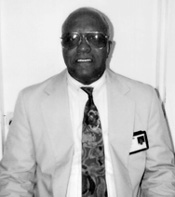
Tilghman, 63, is a high-ranking official in the state Department of Labor. He said he worries that poorly planned development, such as the proposal for a new mall in Jessup, creates "false hope" among people while damaging existing businesses.
"Our community is being polluted by all of these additional business structures and housing going up," Tilghman said. "Developers are going wild; I don't know how they are getting their permits. People in the community don't want this."
-Bill Lambrecht
Register by Aug. 17 to vote in the Sept. 15 primary. Mail-in registration available at your Post Office must be post-marked by Aug. 17.
How Sweet It Is: A.A. County's Winning Water
Photo by Kim Cammarata A.A. County water operator Eddie Cope, left, and regional manager Richard L. Dixon explain how they make good water, below.
Six pairs of hands poised eagerly over their buzzers as the two teams waited for the final questions.
"How much does a gallon of water weigh?"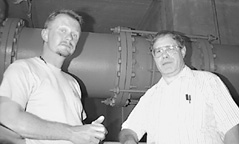
Anne Arundel's team dove for the buzzer. They know the answer to this question as well as they know their own names: 8.34 pounds.
"What is alkalinity?"
Again, the home team lunged for the buzzer, confident that alkalinity is the ability of water to neutralize an acid.
If you're one of the 350,000 Anne Arundel County residents who drink the water this team purifies in the county's public water system, you'll be pleased and proud to know that the home team ranked second in the nation at the American Water Works Association's Top Ops competition in Dallas this summer.
In the Top Ops competition, teams of water quality professionals earn points by correctly answering questions about all aspects of drinking water treatment and supply.
Senior water plant operators Eddie Cope, Terry Bradley and Scott Harmon first won the Chesapeake Section regional competition last fall, which earned them the honor of representing the county Department of Public Works and the Chesapeake Section of the American Water Works Association in the nationwide competition.
At the national competition, Anne Arundel's team cruised into the championship round tied for first place with the defending Top Ops champions from California.
The close competition was not decided until the final two questions of the round. In the end, the defending champions retained their title by a drop, but Anne Arundel's Top Ops team walked away with a sense of pride and accomplishment.
 photo by Kim Cammarata Tony
Pratt monitors A.A. County's water treatment facility, at left.
photo by Kim Cammarata Tony
Pratt monitors A.A. County's water treatment facility, at left.
Cope is proud of his teammates and himself. "It was a really great feeling. Terry Bradley, Scott Harmon and I put a lot of effort into it," he said.
Richard L. Dixon, regional manager of water operations, is also proud of the Top Ops team. He credits the team members for bringing national recognition to the county's water treatment facilities. "They showed initiative and asked to compete. We didn't tell them they had to go through with this competition," Dixon says. "It's something people have to want to do."
Cope, on the other hand, credits the water operations management for encouraging activities that increase the level of knowledge and professionalism at their facilities. "We have such fine management here; they let us have time to study and get ready for the competition," he says.
How does success in the Top Ops competition reflect on the quality of Anne Arundel County's water?
"I think this contest really shows the way we run our water facilities. The county supports and encourages us immensely," says Cope.
Cope and Dixon took time from their workday recently to explain how Anne Arundel County's water treatment facilities make the water safe and tasty.
Most of Anne Arundel County's public drinking water, about 80 percent, comes from county-owned wells, according to Dixon. The county purchases the remaining 20 percent from Baltimore city.
The main problems with most of the county's well water - iron and hydrogen sulfide gas - result in the rotten-egg smelling, orange-staining water with which the 110,000 Anne Arundel residents who rely on well water are all too familiar. The well water also tends to be acidic, which corrodes water pipes and tastes sharp and bitter.
To correct those faults, future drinking water is pumped to a water treatment facility from one or more of the 55 county-owned wells. This untreated water first passes through aerators, which add oxygen to the water.
"Adding oxygen to the water helps remove dissolved solids and dissolved gases," explains Cope.
Adds Dixon: "Putting oxygen in the water causes the iron that's dissolved in the water to form tiny rust particles."
After aeration, water plant operators add lime to decrease the acidity of the water and chlorine to kill bacteria.
"Some people say 'I don't like the taste of chlorine. Why don't you use something else?'" says Dixon. "But chlorine kills bacteria not only within the plant but also in the distribution system. That's why the water is safe."
Next a "weighting polymer" is added and the water flows on to a series of holding basins called flocculators. This procedure helps the particles of iron and other sediment to gather together, becoming heavier.
Now the water moves on to the sedimentation basin. Here the water flows through at a slow but constant speed, and the coagulated particles of iron and other solids drop to the bottom of the tank while the clean water passes through.
"The sedimentation basin is where most of the solids are removed," explains Cope.
The mostly clean water then passes through a filter to remove any remaining fine particles.
Adding flouride - a state-recommended public health measure to help prevent tooth decay - provides the final touch before the water goes on to the underground storage tanks to await delivery to consumers.
In all those steps, Anne Arundel County's water quality professionals aim to meet or exceed state guidelines for safe drinking water. Good tasting water is a by-product of that goal.
"The treatment process removes a lot of the things in the water that cause some taste, like hydrogen sulfide," says Dixon. But, he adds, "the taste of the water varies in different parts of the county."
Anne Arundel County's public drinking water tastes good, according to the Chesapeake Section of the American Water Works Association. A three-judge panel deemed it the best-tasting out of 11 samples from Maryland, Delaware and D.C. in a 1997 taste test.
Dixon adds, "We have a good water source to work with. Once we remove the iron, our water tastes good."
-Kim Cammarata
With Amphibian Return, Solomons Secured
photos by Mark Burns
An infantry landing craft skimmed over the choppy waters of the Patuxent River last weekend. It lodged firmly in the sands and lowered its gate slowly as Marines prepare to storm the beach. After a brief hesitation, the men surged forth, yelling.
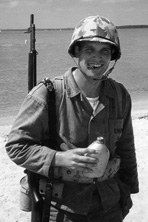 Taking
the only cover they could by laying low on the flat sands, the marines advanced
in periodic charges and laid gunfire on a bunker farther down the beach.
Taking
the only cover they could by laying low on the flat sands, the marines advanced
in periodic charges and laid gunfire on a bunker farther down the beach.
Suddenly, a marine threw flame on the bunker. The rest of the platoon followed up with a final assault of explosives and gunfire.
"I got a little nervous going over the top, so I jammed it in my yap," said 2nd Lt. Ivan F. Ingraham, at right, of his gnarled stogie. He squatted in the sand, directing his men in forming a defensive perimeter.
Rather than enemy fire, these marines encountered a barrage of applause. Their beach-storming on Saturday, August 8, marked the high point in a weekend-long commemoration of the Naval Amphibious Training Base at Solomons, the men who taught and trained there and the 56th anniversary of the invasions at Guadalcanal and Tulagi.
To open the event, Capt. Paul Roberts - commanding officer of the Naval Air Station in St. Mary's - presented a wreath to the World War II veterans who trained at the base. Eight veterans came up to Calvert Marine Museum's Washington Gas Pavilion stage to represent the 67,698 who came through the base. Many other veterans and families filled the audience in a show of respect.
"It's so heartwarming to have someone remember," said former State Sen. Bernie Fowler, who was there with family and friends. His brother-in-law, Lt. Commander Malcom McGaughey, served in the Pacific but never came back. "This really is a good cause, for a good reason, with a good purpose."
David Holly, who skippered a landing craft and landing ship in the Pacific campaign, was among the veterans honored. "It went off pretty well," he said. After the presentation, veterans sailed from the museum to Dowell Peninsula for a private ceremony. There, Holly said, "A large launch took us across to where the base was, and we had our wreath ceremony there on the dock."
Betty Fowler, Vernon Jordan, retired State
Sen. Bernie Fowler, Ronnie Nagers and Louise McGaughey -- Bernie's sister
-- came to commemorate Solomons' role in WWII.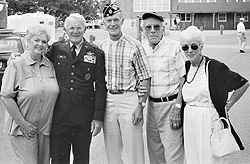
Across the way, in the shadow of the Solomons Bridge, lay Camp Goldstein. Set on the shore of the Patuxent, the World War II camp boasted a medical tent, mess tent and several sleep tents. Here Marines suited up, donning 80 to 100 pounds of gear as camp nurses, the cook and curious bystanders looked on intently. After a quick inspection, they piled into trucks and rode to the John W. Brown, moored on a pier at the Naval Surface Weapons Center at Point Patience.
Historical reenactors brought WWII back to
Solomons at newly named "Camp Goldstein," at left.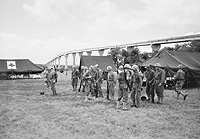
Aboard the Brown, Marines received a final briefing as they rounded the point into the thick of curious boaters. Navy tugs brought her into position and one of the two landing craft moved in alongside. Two cargo nets were dropped into the craft, followed by the platoon climbing in pairs down each net.
On the fishing pier, veterans, kids and adults alike craned their necks and stood on benches to see the landing. On shore, kids and reporters jockeyed for the best angles.
Though the company had run several practice drills, Saturday afternoon was the first time they'd actually landed. "We basically just put our training into practice," said Ingraham.
Whether the training of these historical interpretive specialists will be put into practice again at Solomons remains to be seen.
"It'd be great to see it again," said John Ragland, at the landing with his young sons Mark and Alex.
-Mark Burns
The Curious Case of the Missing Recycler
Somebody call the Hardy Boys.
Crime worries many Southern Marylanders. With burgeoning populations in somewhat unprepared communities, crime can be expected to rise a bit.
But what makes this crime different is that it's ... well ... odd.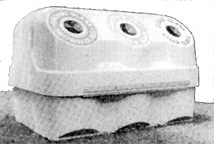
Missing is a 200-pound recycling bin.
During the week of July 12, the five-foot tall, four-foot wide and six-foot long fiberglass six-hole, two-sided glass, plastic and metal recycling bin was removed from the state boat ramp at Hallowing Point.
It was last spotted, says Steve Kullen of the Calvert County Bureau of Solid Waste, "in the back of a pickup truck heading north through North Beach." A second sighting, by a driving instructor from Calvert County, placed the bin and truck near Rose Haven.
So far nobody's been able to give a good description of the truck. What's known is that it was a pickup truck, and it had a big white trash thingy on the back.
What could the motive possibly have been?
"It might make a good feeding trough for cattle," Kullen wryly hypothesizes.
"We've had a couple marinas in Anne Arundel ask us where to get one, but I don't think a marina would send down a bounty hunter to grab it. I really don't know what anybody would want it for. It's just weird."
The trash can itself is valued at over $1,300. But the absence of a black market for used recycling bins kind of makes that a moot point. If it were full, it would have about $20 to $30 of recyclable material in it, according to Kullen. Hardly the big payoff.
No, this crime probably has a different motive. A disgruntled husband tired of hearing his wife nag him about taking out the trash every day? Taking the traveling lawn gnome prank to the next step?
Who knows?
If you have ideas about motives or the bin's whereabouts, mail them in to NBT (Post Office Box 358; Deale, Md. 20751). Or, if you have a serious lead or clue, call it in at 800/560-1004.
And yes, a reward is promised if your tip leads to the bin's safe return.
-MB
Rhode Island this week became the first "flush-free coastal state" by prohibiting emptying of boat toilets in many waters. Boaters can be liable for fines of $2,000 for emptying toilets in Narragansett Bay and up to three miles offshore. Environmental advocates are pleased but many boaters, among them BOAT/US, say the flush-free zone extends too far ...
In Virginia, the state Department of Conservation and Recreation may carve out a state park along a 30-mile stretch of the Rappahannock River. One challenge is avoiding over-use of the Rappahannock, which has a reputation as one of the cleanest rivers in the East ...
Ohio boaters are angry at being told to stay off the Ohio River because of unhealthy levels of bacteria and are demanding that Cincinnati officials get busy with clean-up, the Cincinnati Enquirer reports. The Cincinnati Bengals' new football stadium is a lightning rod for criticism, as boater Edwin Marcotte observed: "We're spending a billion dollars to build stadiums, but there is no goal to clean up the river" ...
Vermont's Middlebury College has announced that it will use only "certified" wood to build its new Bicentennial Hall, thereby becoming the largest academic project in the country to take such a step. Certified wood comes from wisely managed forests rather than exploited rain forests ...
In Brazil, meanwhile, the government announced
last week that it is extending a moratorium for two years on new mahogany
timber operations in much of the Amazon rainforest. The U.S. is the
world's largest importer of mahogany ...
Our Creature Feature comes from Norway, where a team of researchers is trekking to the remote Svalbard Islands because of concern for the health of polar bears.
The Svalbards, which are located near the North Pole, are situated at a crossroads where air and ocean currents bring PCBs and toxic pollution from as far away as Europe and the United States, the San Francisco Chronicle reports.
Researchers from the Norwegian Polar Institute already found seals, otters and mink suffering from sterility and other problems. And last year, a team found seven female polar bears with signs of male organs, likely due to chemical exposure. The team plans to inject 50 polar bears with vaccines, and then return this fall to see how they're doing ...
| Back to Archives |
Volume VI Number 32
August 13-19, 1998
New Bay Times
| Homepage |